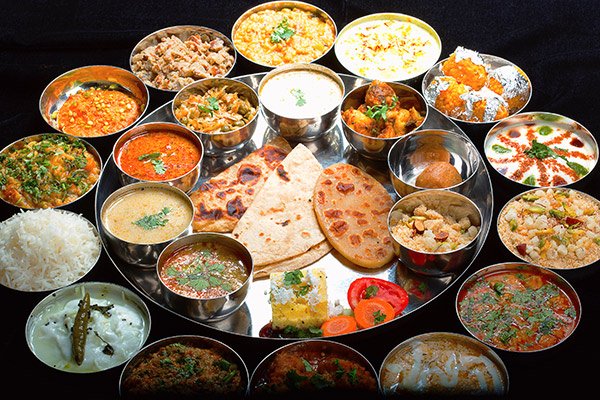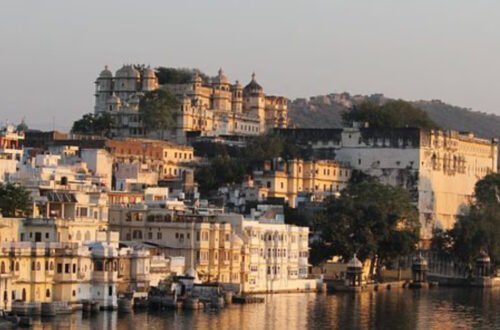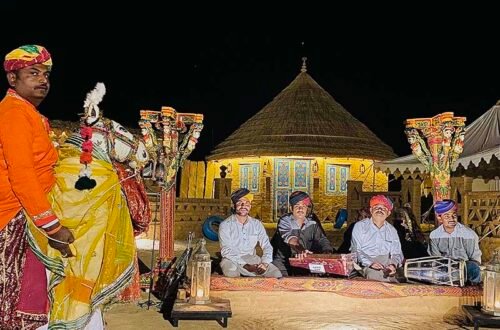Jaipur’s vibrant streets aren’t just a feast for the eyes—they’re a paradise for food lovers. Packed with royal history and bold Rajasthani flavors, the city’s cuisine is deeply rooted in tradition and local culture. Whether you’re wandering through the old city or exploring hidden alleys with locals, food is the gateway to understanding Jaipur’s soul. For those who want to fully immerse themselves, the Best food tour in India is the way to begin.
Dal Baati Churma: The Heart of Rajasthani Cuisine
This iconic dish is synonymous with Rajasthani hospitality. Dal (spiced lentils), baati (crisp wheat balls baked over fire), and churma (sweetened crushed baati with ghee and jaggery) make for a balanced, comforting, and hearty meal. It’s more than food—it’s a cultural ritual. Many local eateries serve this on large thalis, and some traditional homes still prepare it over wood-fired stoves, keeping the centuries-old method alive.
Laal Maas: A Fiery Legacy from the Rajput Kitchens
Originally a favorite among Rajput warriors, Laal Maas is a fiery mutton curry made with Mathania red chilies and garlic. The meat is slow-cooked until tender, absorbing the heat and smokiness of the spices. It’s bold, unapologetically spicy, and served with bajra roti or steamed rice. Though found in high-end hotels, the most authentic versions are usually tucked away in smaller dhabas or family-run restaurants where recipes haven’t changed in decades.
Pyaz Kachori: The Breakfast Staple
You’ll find this flaky, deep-fried snack in every nook of Jaipur—usually served hot with tangy tamarind and coriander chutneys. Stuffed with spicy onion filling, pyaz kachori is a breakfast favorite and an afternoon craving. LMB and Rawat Misthan Bhandar are famous spots, but local vendors often serve up crispier and more flavorful versions. Watch the locals—if there’s a crowd around a stall, that’s your sign.
Rajasthani Kadhi: A Tangy Take on Comfort
Unlike its Punjabi counterpart, Rajasthani kadhi is thinner and tangier, made without pakoras. It’s light but flavorful, often paired with steamed rice or khichdi. The sour notes from buttermilk balance well with the tempered spices. What makes it special in Jaipur is the addition of local ingredients like ker sangri pickle on the side, elevating the humble dish to something memorable.
Mirchi Bada: A Street Food Essential
Hot green chilies stuffed with spiced potatoes, dipped in besan batter, and fried till golden—Mirchi Bada is the perfect mix of heat and crunch. Vendors typically serve it with imli chutney or mint sauce. Despite the intimidating size of the chili, the filling cuts down the heat, making it accessible even for those wary of spice. The best time to try it? Rainy afternoons, just like the locals do.
Gatte ki Sabzi: Chickpea Dumplings with a Punch
This traditional curry made with gram flour dumplings in a spiced yogurt gravy is a vegetarian staple in every Rajasthani household. The gatte (dumplings) are boiled, sliced, and added to the rich, tangy sauce. Some versions incorporate curd-based gravy while others use tomato or onion bases. Paired with steamed rice or missi roti, this dish is an excellent introduction to the balance of spice and flavor in the local cuisine.
Ker Sangri: Desert Plants Turned Delicacy
A dish born out of necessity in the arid lands of Rajasthan, ker sangri is a unique combination of desert berries and beans, cooked with minimal water and lots of spices. The result is tangy, earthy, and slightly crunchy—best enjoyed with bajra roti and ghee. Many travelers skip it, mistaking it for a mere side, but it’s one of the most traditional and resilient dishes of the region.
Mawa Kachori: A Sweet Ending
This dessert flips the usual savory kachori into a sugary indulgence. Filled with sweetened khoya (mawa), dry fruits, and cardamom, then deep-fried and soaked in sugar syrup—mawa kachori is rich and decadent. It’s often served during festivals and special occasions but is available year-round at iconic sweet shops like LMB. Locals often buy a box to gift or take home, and it’s easy to see why.
Traditional Drinks to Cool Down
No food experience in Jaipur is complete without sipping on some of its traditional beverages. Try chaach (spiced buttermilk), which cools the stomach after a spicy meal. There’s also jaljeera, made from cumin and mint, often served chilled and used as a natural digestive. For something sweet, lassi from a clay cup is both refreshing and filling—perfect for mid-day breaks between street food stops.
Why Guided Food Tours in Jaipur Are Worth It
Trying these dishes is one thing, but understanding the stories behind them adds a deeper appreciation. The Jaipur food walk tour offers just that—an on-foot journey into the kitchens, markets, and stories that define Jaipur’s food culture. You’ll meet the people behind the pans, sample time-tested family recipes, and discover food you’d likely miss if wandering alone. For first-time visitors or even repeat travelers, this curated local experience often becomes the highlight of their trip.
Final Bite
Local cuisine in Jaipur isn’t just about taste—it’s about heritage, geography, and pride. From royal kitchens to humble street carts, every dish has a tale. And the best way to hear those tales? Sit down with the food, listen to the vendors, and eat like a local. Whether you’re after spicy curries or indulgent sweets, Jaipur’s food scene offers a full-sensory experience that goes far beyond the plate.





